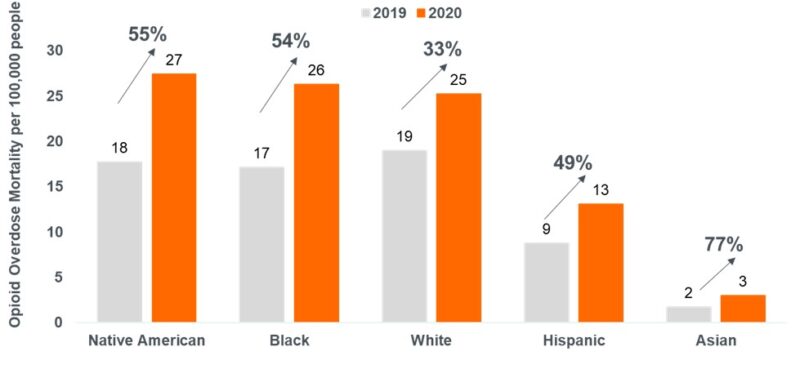Racial Disparities Amid the Opioid Epidemic
With more than 100,000 drug overdose deaths in the US between April 2020 and April 2021, an estimated 75,673 were reported to involve opioids.1 However, the growth in mortality is not affecting our communities equally.2 Recent research shows that the communities most affected by healthcare inequities — Black, Native American, Hispanic and Asian — are now seeing the largest percentage increases in overdose deaths.2
The latest data
Research from the National Institute on Drug Abuse (Figure 1) shows that the percentage increase in overdose deaths per 100,000 people among minority populations has been disproportionately high in recent years.2
Figure 1. Overdose Deaths by Ethnicity2
Opioid Overdose Mortality Rate by Racial/Ethnic Group2

According to research published in 2021, a possible reason for this demographic shift is because minorities do not have equitable access to naloxone medications like Kloxxado® compared to their White counterparts.3
The role of fentanyl in drug overdose deaths
Illicitly manufactured fentanyl (IMF) appears to be driving the current wave of opioid overdose deaths in the US.4 In recent years, the contamination of substances with IMF has become increasingly common.5-8 People may believe they are buying a non-opioid such as cocaine.5,7,8 Instead, they may be getting a lethal dose of IMF.5,7,8
Data from the National Institute on Drug Abuse (Figure 2) indicates that synthetic opioids often are involved in overdose deaths associated with other substances.3
Type of Overdose Death |
Percentage Involving Synthetic Opioids |
|---|---|
| Involving Cocaine | 71% |
| Involving Benzodiazepines | 65% |
| Involving Other Stimulants | 49% |
| Involving Antidepressants | 43% |
Figure 2. Drug Overdose Deaths Involving Synthetic Opioids9
Minority populations are subjected to inequitable access to naloxone
Although cases of overdose involving opioids among minorities appear to be rising, the same unfortunately cannot be said for naloxone access.3 A study conducted in Los Angeles and San Francisco of 536 people who injected drugs from 2017 to 2018 assessed patterns of initial naloxone access and subsequent naloxone refills (known as the naloxone engagement and re-engagement cascade).3 Overall, the study found that people who identify as Hispanic or Black were less likely to have recently received naloxone than their White counterparts.3
The time for change is now
At Hikma Community Health™, we recognize that these different communities may need different solutions and are working to engage advocacy groups to ensure they have access to naloxone medications like Kloxxado.®3,9 Solutions for these communities must recognize the unique challenges faced by these communities, as well as the unique social support networks these communities use to support themselves and each other. Only through genuine partnership can we identify solutions that will work for the diverse communities affected by the opioid epidemic.
NOTE: This article was not written by a medical professional and is not intended to substitute for the guidance of a physician. These are not Hikma’s recommendations, but rather facts and data collected from various reliable medical sources. For a full list of resources and their attributing links, see below.
HK-1961-v1
References
- Drug Overdose Deaths in the US Top 100,000 Annually. Centers for Disease Control and Prevention/National Center for Health Statistics website. Available at: Drug Overdose Deaths in the U.S. Top 100,000 Annually (cdc.gov). Accessed August 23, 2022.
- Overdose Death Rates. National Institutes of Health/National Institute on Drug Abuse website (Source: CDC Wonder). Available at: Overdose Death Rates | National Institute on Drug Abuse (NIDA) (nih.gov). Accessed August 23, 2022.
- Kinnard EN, Bluthenthal RN, Kral AH, Wenger LD, Lambdin BH. The naloxone delivery cascade: Identifying disparities in access to naloxone among people who inject drugs in Los Angeles and San Francisco, CA. Drug and Alcohol Dependence. 2021;225:108759.
- Understanding the Opioid Overdose Epidemic. Centers for Disease Control and Prevention website. Available at: Understanding the Opioid Overdose Epidemic | CDC’s Response to the Opioid Overdose Epidemic | CDC. Accessed August 23, 2022.
- Fentanyl DrugFacts/What is fentanyl? National Institute on Drug Abuse website. Available at Fentanyl DrugFacts | National Institute on Drug Abuse (NIDA) (nih.gov). Accessed August 23, 2022.
- Somerville NJ, O’Donnell J, Gladden RM, et al. Characteristics of Fentanyl Overdose — Massachusetts, 2014–2016. MMWR/Morb Mortal Wkly Rep. 2017;66:382–386.
- NVSS Vital Statistics Rapid Release/Provisional Drug Overdose Death Counts. Centers for Disease Control and Prevention website. Available at: Products – Vital Statistics Rapid Release – Provisional Drug Overdose Data (cdc.gov). Accessed August 23, 2022.
- DEA Washington Chief Issues Public Safety Alert: Dangerous Increase in Fake Rx Pills Containing Fentanyl. United States Drug Enforcement Administration website. Available at: https://www.dea.gov/press-releases/2021/09/27/dea-washington-chief-issues-public-safety-alert-dangerous-increase-fake. Accessed August 23, 2022.
- Overdose Death Rates. National Institute on Drug Abuse website. Available at: Overdose Death Rates | National Institute on Drug Abuse (NIDA) (nih.gov). Accessed August 23, 2022.






